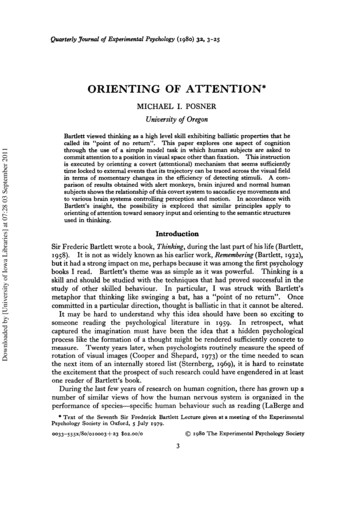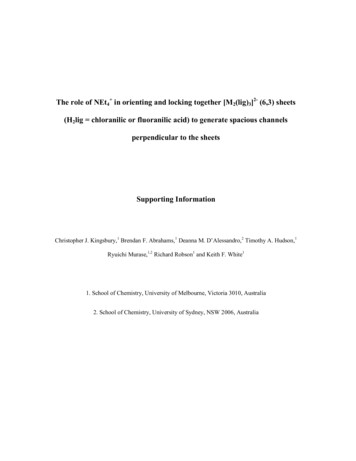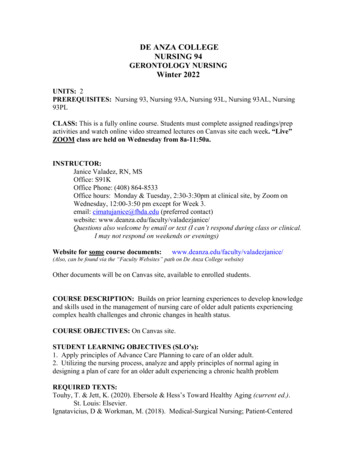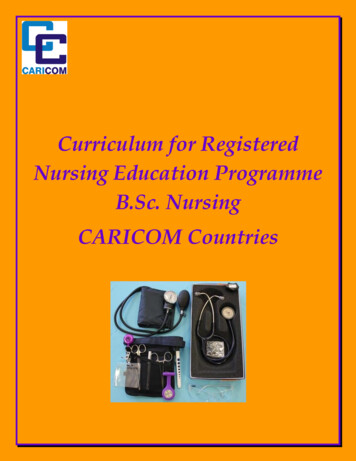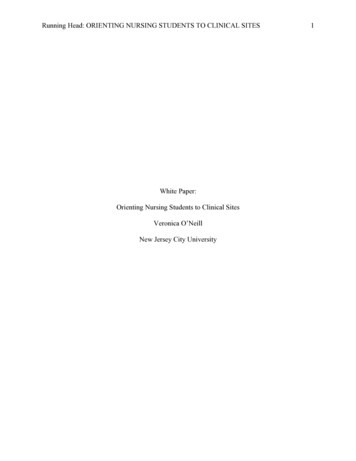
Transcription
Running Head: ORIENTING NURSING STUDENTS TO CLINICAL SITESWhite Paper:Orienting Nursing Students to Clinical SitesVeronica O’NeillNew Jersey City University1
ORIENTING NURSING STUDENTS TO CLINICAL SITES2White Paper: Orienting Nursing Students to Clinical SitesIntroductionNursing students spend time in many different practice settings during their trainingprogram. They care for patients in long-term-care facilities, hospitals and in the community. Ineach of these settings, they must be familiar with the emergency procedures which are specific tothe location, so they can assist as needed in a fire, evacuation, or medical emergency situation.This White Paper will examine the current practice of orientation in these clinical settings, andpropose a solution using iBeacon technology to convey necessary information to nursingstudents.Problem StatementInteracting with and caring for actual patients in a clinical setting is an essential part ofnursing education. The New Jersey Board of Nursing requires that Registered ProfessionalNursing programs provide an equal number of hours of theoretical study and clinical experiencein the program (NJ Consumer Affairs, 2011). Some of this clinical time may be spent in asimulation lab, but the National League for Nursing has maintained that at least 50% of theclinical hours must be in an actual practice setting (National League for Nursing, 2015). To meetthese requirements, nursing programs arrange for clinical placements for their students in manysettings, including long-term-care facilities, hospital units, and community nursing sites. Each ofthese settings has specific emergency procedures, and it is imperative that all personnel at thelocation be aware of what to do in the event of an emergency.Nursing students assigned to a clinical setting must be familiar with fire and evacuationprocedures, and be aware of the location of medical equipment such as crash carts. Currently,
ORIENTING NURSING STUDENTS TO CLINICAL SITES3when a group of students begins a clinical rotation, their instructor provides a paper-basedscavenger hunt. As students locate each item on the scavenger hunt, they check it off their sheet.There are some limitations to this process. Even in the best case scenario, students physicallylocate all of the emergency equipment, such as the fire alarm box, fire extinguisher, and crashcart. They do not have the opportunity to review the emergency procedures for that particularequipment at the time of the scavenger hunt. In the worst case scenario, students can merelycheck off that they visited all locations.In discussions with faculty members at the New Jersey City University NursingDepartment, the possibility of building a more robust orientation experience using technologywas explored. There were several requirements identified during these discussions. First, therecould be no permanent installation of equipment at the clinical sites. Any equipment used mustbe easy to transport, easy to set up, and easy to remove quickly at the end of the clinical session.No additional staff could be utilized to deploy the equipment. Ideally, the technological solutionwould allow for some sort of assessment at the end of the exercise, to ensure completion of theexercise and understanding of the materials reviewed.Proposed SolutioniBeacon technology is an emerging technology that is being used in many settings. It usesa low-power Bluetooth signal to transmit a signal to a nearby receiving device, such as asmartphone or iPad. When the receiving device receives the signal, additional information istransmitted to the device through the Internet, such as marketing material or information about amuseum exhibit. The technology is most familiar in retail settings, such as the Apple Store,where iBeacons were introduced in 2013 to assist customers in selecting and paying formerchandise (AppleInsider, 2013). This technology has also been utilized by libraries, museums
ORIENTING NURSING STUDENTS TO CLINICAL SITES4and other locations to assist and engage visitors and provide enrichment materials (Dempsey,2016; Graceland, 2014; Kern, 2016). The devices are also being promoted for use in education(Locly, 2014). Recently, iBeacons have been used in a self-guided tour of the A. Harry MooreSchool, showcasing the school’s history and present operations (AHMiBeacon Project, 2015).There are several advantages to the choice of iBeacons for the Nursing Orientationproject. All of the NJCU nursing students are issued an iPad at the beginning of their program, sothere is no issue with availability of devices. The app needed to interact with the iBeacons, LoclySandbox, is free. The iBeacons are programmed using the free Project application on theLocly.com website. Using this application, photos, video or audio can be uploaded andassociated with particular iBeacon devices. Each iBeacon can also link to supplemental material,such as the procedure for operating a fire extinguisher. The content can also include embeddedGoogle forms, to capture feedback and assessment data. The information on the Projectapplication can be updated easily, with no programming required. Maintenance on the iBeacondevices is limited to changing the batteries, which are expected to last 1 to 2 years.The initial investment for the iBeacon devices for this initiative was 249, direct from themanufacturer, for 8 beacons. However, these beacons can be reprogrammed for many differentclinical settings, by creating new Projects on the Locly website, so only one set of iBeacons isneeded. In most existing cases, iBeacons are installed in permanent or semi-permanent locations,but in this situation, portability is a key feature. This problem was overcome by mounting theiBeacons on a Lucite photo frame with Velcro. The frames are easily set up and collected in amatter of minutes.The project timeline for this application is available in Appendix A. To date, theprogramming of the iBeacons for one specific clinical location has been completed, and the
ORIENTING NURSING STUDENTS TO CLINICAL SITES5project has passed initial acceptance testing by the Nursing Department. The next step will be atest in the Nursing Simulation Lab, assisted by current students, to gather feedback and reaction.Based on this feedback, the programming may be adjusted. In the Spring semester, the iBeaconswill be deployed for live orientation of students.Selected screenshots of the Orientation Project on the Locly Sandbox app are attached inAppendix B, as well as a copy of the Google form used for assessment and feedback, inAppendix C.The project has been submitted to ISTE 2017 as a poster session. The proposal submittedis attached as Appendix D, and a link to the companion website for the presentation is includedin Appendix E.ConclusionThe Nursing Department is beginning a new initiative to enhance its students’ experienceduring orientation to new clinical sites. This will be accomplished through the use of iBeacontechnology, combined with the Locly Sandbox app. This technology will allow students toreceive important information about emergency procedures in the clinical location, and willassess their retention of the information presented. This solution was chosen because it isflexible, content can be updated easily, and the iBeacon devices can be reused for multipleclinical sites.
ORIENTING NURSING STUDENTS TO CLINICAL SITES6Appendix AOrienting Nursing Students to Clinical Sites with iBeaconsProject TimelineSeptember 2016 October 2016 November/December 2016 January 2017 February 2017 Summer 2017/Fall 2017 Determine specifications with NursingDepartmentComplete background researchComplete video tutorials to learnLocly applicationsSubmit proposal for posterpresentation to ISTE 2017Obtain clinical site content fromNursingLoad content to Locly Project siteProgram iBeacons to link to Locly appTest Locly appDeliver iBeacons and Projectapplication to NursingTesting in Simulation Lab by currentnursing studentsAdjust programming based onfeedback from studentsDeploy iBeacons in an actual clinicalrotationAdjust as needed based on feedbackand performancePresent project at a major conference
ORIENTING NURSING STUDENTS TO CLINICAL SITESAppendix BScreenshots of Locly Sandbox app:7
ORIENTING NURSING STUDENTS TO CLINICAL SITESAppendix CAssessment8
ORIENTING NURSING STUDENTS TO CLINICAL SITES9
ORIENTING NURSING STUDENTS TO CLINICAL SITESAppendix DProposal for poster presentation at ISTE10
ORIENTING NURSING STUDENTS TO CLINICAL SITES11
ORIENTING NURSING STUDENTS TO CLINICAL SITES12
ORIENTING NURSING STUDENTS TO CLINICAL SITESAppendix ECompanion website for ISTE presentation:http://bit.ly/NJCUiBeacons13
ORIENTING NURSING STUDENTS TO CLINICAL SITES14ReferencesAHMiBeaconProject (2015). A. Harry Moore iBeacon Project. Retrieved sider (2013). First look: Using iBeacon location awareness at an Apple Store. Retrievedfrom reDempsey, K. (2016, May). Bluetooth beacons are starting to shine in libraries: when a beaconrecognizes an equipped smartphone, it pings out its message. Computers in Libraries,36(4), 28 . Retrieved from Graceland (2014). All new interactive iPad tour revolutionizes guest experience at ElvisPresley’s Graceland. Retrieved from at-elvis-presleys-graceland/7519/Kern, J. (2016). App guides users through Stations of the Cross tour at St. Thomas Episcopal.Retrieved from http://lancasteronline.com/features/faith ss-tour-at/article 6c1329ce-c50b-11e3-98cb0017a43b2370.htmlLocly (2014) Getting started with Locly Sandbox for education. Retrieved d-with-the-locly-i-beacon-appNational League for Nursing (2015). A Vision for Teaching with Simulation. Retrieved rsn 2
ORIENTING NURSING STUDENTS TO CLINICAL SITESNew Jersey Division of Consumer Affairs (2011). Information for Registered ProfessionalNursing Programs. Retrieved sional-Nursing-Programs.pdf15
New Jersey City University . ORIENTING NURSING STUDENTS TO CLINICAL SITES 2 White Paper: Orienting Nursing Students to Clinical Sites . The New Jersey Board of Nursing requires that Registered Professional Nursing programs provide an equal number of hours of theoretical study and clinical experience in the program (NJ Consumer Affairs, 2011). .
